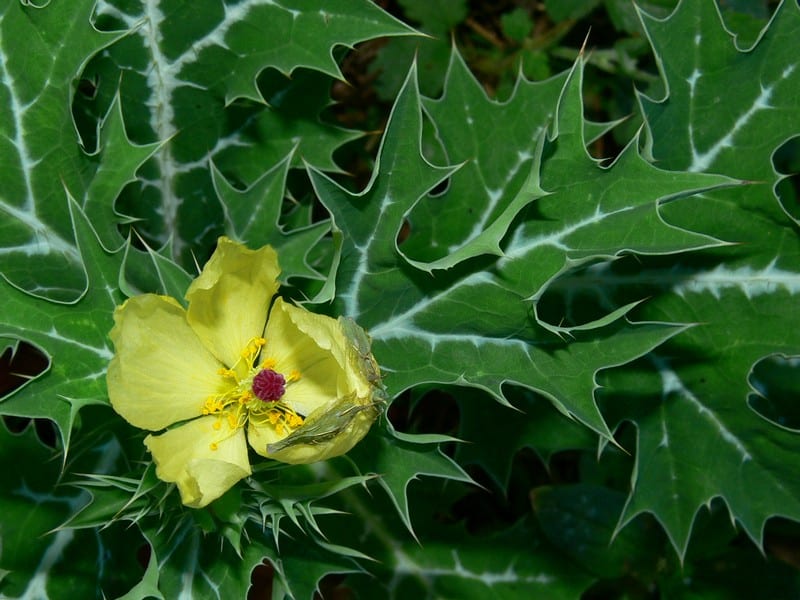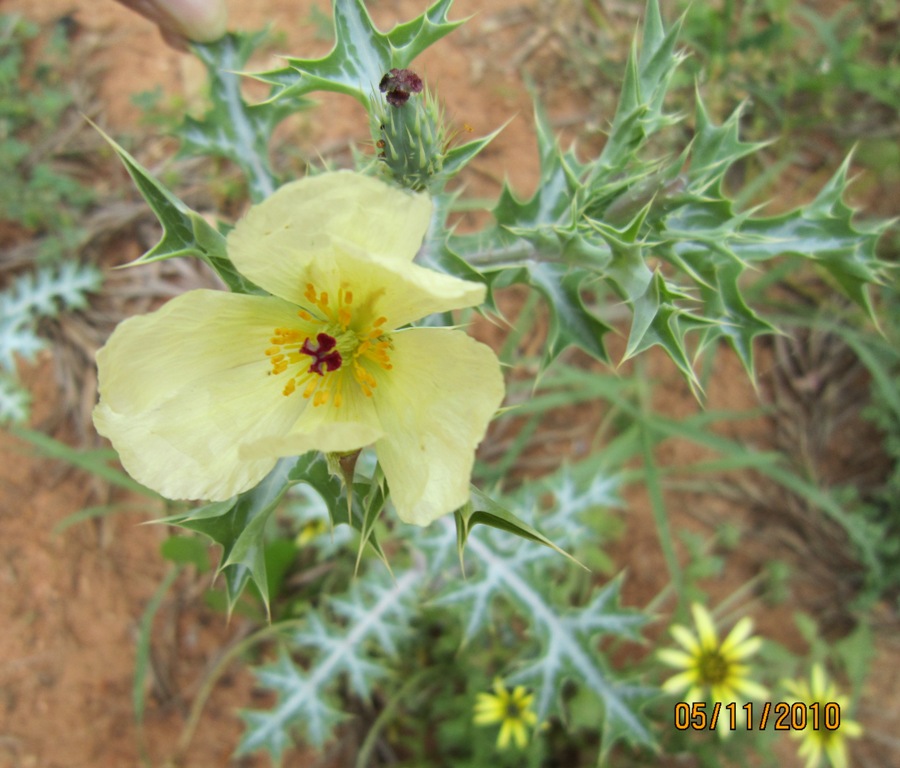Land for Wildlife & Garden for Wildlife Alice Springs Mexican Poppy
Mexican prickly poppy ( Argemone mexicana ), also known as goatweed, Mexican thistle, prickly poppy, and yellow thistle, is a member of the poppy family (Figure 1). It is an annual or biennial plant that is found east of the Rocky Mountains, Hawaii, and Puerto Rico. In Florida, it is typically recognized as 'some type of thistle' until it flowers.

Argemone Mexicana, Mexican Prickly Poppy, Roadside Weed Stock Photo
Argemone mexicana is a PERENNIAL growing to 0.6 m (2ft) by 0.5 m (1ft 8in). See above for USDA hardiness. It is hardy to UK zone 8. It is in flower from June to August, and the seeds ripen from July to September. The species is hermaphrodite (has both male and female organs). The plant is self-fertile.

Mexican Poppy, town weed Matthewtown. Inagua. Argemone. Pr… Flickr
Argemone ochroleuca. Argemone ochroleuca is a species of prickly poppy, a flowering plant commonly known as pale Mexican prickly poppy or Mexican poppy. It is native to Mexico and is also an introduced weed in many temperate and tropical regions of the world. [1] It can grow up to 1 m (3 ft 3 in) in height and has a sticky yellow sap.
Mexican poppy Argemone Mexicana
Mexican poppy is an erect annual herb growing up to 1.5 m high. The leaves are alternate, irregularly lobed and up to 12 cm long. They are bluish green or greyish green with white mottling and have small yellow spines at the end of each lobe. Flowers are cream to pale yellow with 6 petals and are 3 - 7 cm in diameter.

SPIKY LEAVES of MEXICAN POPPY WEED Stock Photo Image of dark, sharp
Mexican poppy, prickly poppy, devil's fig, golden thistle of Peru, biniguy thistle, white thistle, yellow poppy, Mexican thistle, Mexican prickle poppy. Family. Papaveraceae. Origin. Native to tropical America but its exact native range is disputed.. Controlling the weed before it seeds will reduce future problems. Control is generally best.

Medicinal Properties and Health Benefits of Mexican Poppy Seeds
Mexican poppy, Mexican prickly poppy, Medicinal weed, satyanashi, prickly poppy, ekijembajembe (Ankole), mkumajalaga (Yao) Family. Papaveraceae. Origin. The exact native range of this species is obscure, but it is often thought to be native to south-eastern USA (Florida), Mexico, Central America, the Caribbean and tropical South America. Others.

Argemone Ochroleuca, Pale Mexican Prickly Poppy, Roadside Weed Stock
Argemone mexicana - MHNT Flower bud of prickly poppy, which is a common weed of India. Picture is taken at Beliatore, West Bengal, India. Argemone mexicana (Mexican poppy, Mexican prickly poppy, flowering thistle, cardo or cardosanto) is a species of poppy found in Mexico and now widely naturalized in many parts of the world. An extremely hardy pioneer plant, it is tolerant of drought and.

PALE YELLOW FLOWER of MEXICAN WEED POPPY in the SUN Stock Photo Image
Mexican poppy, Devil's fig, Golden thistle of Peru, Biniguy thistle, White thistle, Yellow poppy, Mexican thistle, Mexican prickle poppy. A glaucous (blue-green) erect single to several stemmed annual with yellow sap,with a central taproot. It grows from 60 to 120cm in height. It has leafy stems that grow up to 60cm, with prickly lobed leaves.

Mexican poppy, prickly poppy Central QLD Coast Landcare Network
Mexican poppy ( Argemone ochroleuca) is a member of the poppy family Papaveraceae and is native to Texas, Mexico and central America. Mexican poppy is widely established as a weed in the tropics. It has been introduced to Queensland and New South Wales and has become a troublesome weed in parts of Western Australia.

Argemone Mexicana, Mexican Prickly Poppy, Roadside Weed Stock Photo
The annual weed can grow up to 120cm tall, yet is usually 20 to 40cm tall. The weed is distinct in three ways (i) its variegated leaf colour, (ii) the leaves being prickly and lobed in shape which can grow up to 20cm long, and (iii) its distinct yellow flower which have a dark red 3 to 6 lobed stigma present. The weed is a prolific seeder.

Mexican poppy weeds in Western Australia Agriculture and Food
In many locations worldwide, it has become a nuisance plant in crops and is listed as a serious agricultural weed. Where fields or pastures have been overgrazed, its invasive nature has allowed it to multiply. In addition to humans, this plant is toxic for grazing animals. The solitary, showy flowers form at the tips of the branches.

Argemone Ochroleuca, Pale Mexican Prickly Poppy, Roadside Weed Stock
Mexican poppy has grown quite a reputation for bringing a lot of health benefits since it contains antispasmodic, analgesic, hallucinogenic, antibacterial, anticancer, sedative, and anti-inflammatory properties. In Ayurveda medicine, for example, this plant is well-known to treat several health conditions. It is even used as a homeopathic drug.

LIFE AT SAINT ANDREWS
Argemone Mexicana, the Mexican poppy, also known as Mexican poppy, Yellow thistle, Mexican pricklepoppy, Prickly poppy, Amapolas del Campo, Bermuda Thistle, Brahmadanti, Caruancho, Gamboge Thistle and Flowering Thistle, is a robust and erect herb with decorative yellow flower. The plant has sharp prickles on its stem. It grows in a tropical.

Mexican poppy, prickly poppy Central QLD Coast Landcare Network
Although President Andrés Manuel López Obrador has disavowed targeting Mexican poppy farmers, some aerial spraying of poppy crops persisted in 2019. In 2018, eradication was estimated to have.

Mexican poppy, prickly poppy Central QLD Coast Landcare Network
Mexican poppy weed. Excessive competition from weeds is a significant constraint in South African corn fields, reducing corn yield and farmer's income (Marava Citation 2016).Weeds must be controlled even in the dry season, as some invasive weed species such as Mexican poppy (Argemone mexicana) have a deep-reaching root system, which taps water from deep soil layers (Steiner and Rockström.

"Mexican Poppy" by mindy23 Redbubble
Mexican pricklypoppy (Argemone mexicana) is a native Florida landscape weed. Young plants are often mistaken for thistles due to their prickly and toothed leaves. When broken, plants exude a yellowish-milky sap.. Mexican Prickly Poppy: Biology and Control; Relevant Resources. UF/IFAS Extension Publication - Mexican Prickly Poppy: Biology and.